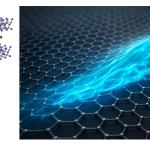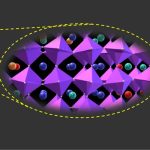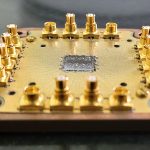
In recent years, a phenomenon called the quantum Hall effect has emerged as a platform for hosting exotic features called quasiparticles, with properties that could lead to exciting applications in areas like quantum computing. When a strong magnetic field is applied to a 2D material or gas, the electrons at the interface – unlike the ones within the bulk – are free to move along the edges in what are called edge modes or channels – somewhat similar to highway lanes. This edge movement, which is the essence of the quantum Hall effect, can lead to many interesting properties depending on the material and conditions.
For conventional electrons, the current flows only in one direction dictated by the magnetic field (‘downstream’). However, physicists have predicted that some materials can have counter-propagating channels where some quasiparticles can also travel in the opposite (‘upstream’) direction. Although these upstream channels are of great interest to scientists because they can host a variety of new kinds of quasiparticles, they have been extremely difficult to identify because they do not carry any electrical current.
In a new study, researchers from IISc and international collaborators provide “smoking gun” evidence for the presence of upstream modes along which certain neutral quasiparticles move in twolayered graphene. To detect these modes, the team used a novel method employing electrical noise – fluctuations in the output signal caused by heat dissipation.
“Though the upstream excitations are charge-neutral, they can carry heat energy and produce a noise spot along the upstream direction,” explains Anindya Das, Associate Professor in the Department of Physics and corresponding author of the study published in Nature Communications.
Quasiparticles are largely excitations that arise when elementary particles like electrons interact among each other or with matter around them. They are not truly particles but have similar properties like mass and charge. The simplest example is a ‘hole’ – a vacancy where an electron is missing in a given energy state in a semiconductor. It has an opposite charge to the electron and can move inside a material just like the electron does. Pairs of electrons and holes can also form quasiparticles which can propagate along the edge of the material.
In previous studies, the researchers have shown that it might be possible to detect emergent quasiparticles like Majorana fermions in graphene; the hope is to harness such quasiparticles to eventually build fault-tolerant quantum computers. For identifying and studying such particles, detecting upstream modes which can host them is critical.
In the current study, when the researchers applied an electrical potential to the edge of two-layered graphene, they found that heat was transported only in the upstream channels and dissipated at certain ‘hotspots’ in that direction. At these spots, the heat generated electrical noise that could be picked up by an electrical resonance circuit and spectrum analyser.
The authors also found that the movement of these quasiparticles in the upstream channels was ‘ballistic’ – heat energy flowed from one hotspot to another without any loss – unlike the ‘diffusive’ transport observed earlier in galliumarsenide based systems. Such a ballistic movement is also indicative of the presence of exotic states and features that could help build energy-efficient and faultfree quantum components in the future, according to the authors.






